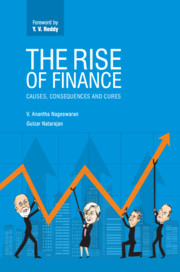7 - Finance in India
from Part C - The Cure
Published online by Cambridge University Press: 02 May 2019
Summary
Introduction
The earlier chapters focused on the rise of finance mostly in the context of advanced economies. This chapter examines its relevance for India. It goes further than that – it evaluates the state of the financial sector in India. As with many things, India's finance sector too is a phenomenon of many parts. Some are rudimentary and some are sophisticated. Unlike the advanced economies, India's challenges are different. On the one hand, a significant share of its citizens is financially excluded and its credit markets suffer from several deficiencies. On the other hand, pockets of the economy as well as certain economic activities are experiencing an increasing trend of financialization. India needs to walk this trade-off going forward.
As a large continent-sized economy with many states of the sizes of countries in Europe and Africa folded in it, India is always in a state of churn. But India's financial sector seems to be in a particular state of heightened churn. Fortunately, crises and churns always provide opportunities for charting a new path, a better road map for the future. Indeed, a lot has been achieved. One way to gauge that is to look back at the agenda that was deemed essential for India sometime in the past and see how much of it has been achieved.
In 2008, Raghuram Rajan had delivered a speech at the Institute for Economic Growth in Delhi on the topic of financial sector reforms in India and the global crisis. In the speech, he had recommended that India implement a bankruptcy code, make it easy for foreigners to invest in Indian bond market, enable no-frills accounts for the vast majority of the population and establish credit bureaus and allow foreign direct investment in asset reconstruction companies. In the decade since, all of these have been accomplished. Yes, many things remain to be done but much has been done too. This is the state of affairs in Indian public policy, in general. Given its continental size and huge population, issues will keep surfacing even as some are settled.
For analytical comfort, we can distinguish between finance and financialization for a developing country. Developing countries need access to finance, especially for their low-income citizens and small and medium enterprises (SMEs).
- Type
- Chapter
- Information
- The Rise of FinanceCauses, Consequences and Cures, pp. 207 - 263Publisher: Cambridge University PressPrint publication year: 2019



